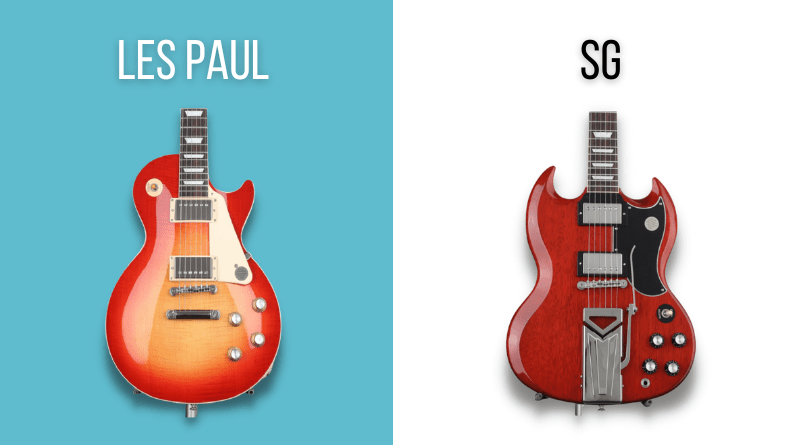When a guitar enthusiast gets going about their favorite model, things can get pretty heated. So, you can already guess what happens when you set off a conversation about two of the world’s most popular models – the Gibson SG vs Gibson Les Paul debate is one such comparison, and it often results in fireworks.
Both models are of course iconic in their own right, but which is better, and why? In this KillerGuitarRigs Guide, we engage in an in depth analysis of both models, comparing them directly to give you an apples to apples view of both models to help you choose the right one for you.
If you’re in the market for one (or both) of these guitars then this is a piece you won’t want to miss – keep on reading for more.
Contents
Main Differences
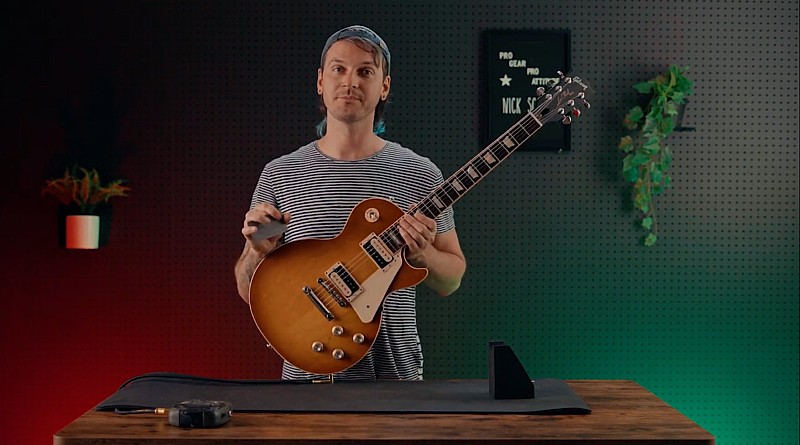
While the Les Paul and the SG do have many features in common, there are still enough differences to make them totally different guitars in terms of feel, playability, and tone. Here are some of the biggest differences at a glance.
Body Shape
The biggest difference between the Les Paul and the SG is, quite obviously, the body shape. The Les Paul has a very rounded lower bout, with a single cutaway on the treble side for upper fret access. The SG on the other hand, has a more squat lower bout with 2 horned cutaways.
The SG also has a thinner body, with contours on the top and the back that provide improved comfort.
Another difference is in the availability of different neck profiles. The Les Paul can be bought with either a chunky vintage ‘50s profile, or a Slimtaper ‘60s profile. The SG on the other hand only comes with the SlimTaper option.
Materials
Both the Les Paul and the SG (traditionally) have mahogany necks, and mahogany bodies. The main difference here is in the fact that (with the exception of the Special and Junior models) the Les Paul has a maple cap atop the mahogany.
Hardware
Besides special editions, the Les Paul is strictly a hardtail model. It comes with a Tune-O-Matic bridge and a stopbar tailpiece. While many versions of the SG also feature this setup, it’s also possible to buy the SG with a Maestro Vibrola vibrato system option.
Les Paul
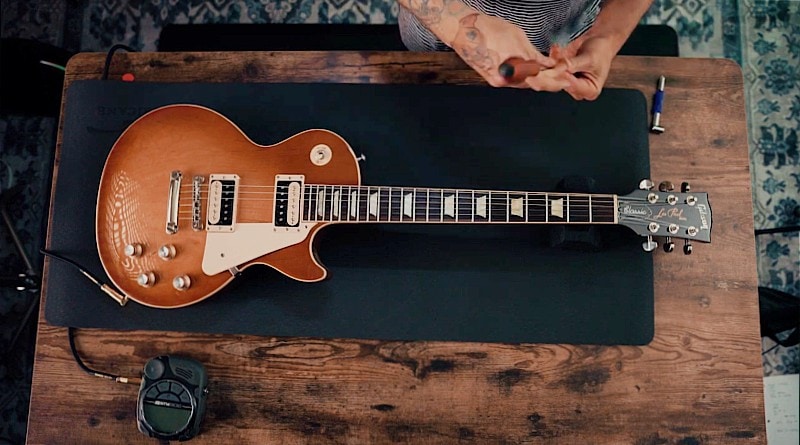
The Gibson Les Paul was first introduced in 1952. To this day, it remains one of the most popular and well recognized guitars in the world. It’s known for its timeless design, huge sound, and incredible build quality.
Without a doubt, the Les Paul is one of the most popular models made by Gibson. This is partially down to the fact that so many of the all time greats have become synonymous with this guitar, including Jimmy Page, Eric Clapton, Peter Frampton, Joe Perry, and of course, Slash.
For many guitar enthusiasts, owning a vintage Les Paul is considered the Holy Grail. Pre 1961 Les Pauls are particularly sought after, in fact, some vintage Les Pauls can be worth as much as $400,000, making them some of the most valuable guitars in existence.
From a design perspective the Les Paul has held up extremely well over the years. Its classic looks have stood the test of time, making it a favorite among guitar players of literally all genres.
Construction
The Les Paul is a solid body guitar made in a rather unique way. The bulk of the body is made with mahogany, and cut into a rounded, single cut shape. On top of the mahogany, there is a carved maple cap.
The maple cap was added for a couple of reasons. First, it provided some brightness to the tones to counteract the darkness of all the mahogany, and second, being harder than mahogany, maple is a better material to mount the bridge and tailpiece to as it allows more of the string vibration to pass through to the body than softer woods. Les Pauls are also known for their set neck design, in which the neck is wedged and glued into position on the body.
Atop the neck is (in almost all cases) a gorgeous rosewood fretboard. Rosewood has been historically used for both its performance in terms of feel and sound, as well as its aesthetics. The top of the line Custom models are fitted with ebony fretboards, primarily to match the tuxedo appearance of these (typically) black or white guitars.
The bodies of each Gibson Les Paul are finished in real nitrocellulose lacquer, which will, over time age naturally, leading to the ever coveted worn, or “relic” finish.
Most non Junior or Special Les Paul models are equipped with a pair of humbucking pickups. The Junior and Special are equipped with a single P90 and dual P90s respectively, and there are of course some limited run models that have active pickups.
Tones
There are a few contributing factors to the Les Paul tone that are also partially responsible for its enormous success over the last 6 decades.
The overall sound of a Les Paul is rich and warm. This is largely driven by the heavy mahogany body, although the maple cap does give it some snap and brightness. The pickups are warmer and fatter than anything you’d find on a single coil guitar like a Strat, and because they are (usually) humbucking pickups, they don’t suffer from the 60 cycle hum that plagues single coil guitars.
Some models do come with coil splitting pickups, too. This means they can be converted to operate as single coil pickups simply by pulling out one of the knobs.
The combination of the heavy body and the humbucking pickups also leads to massive sustain and excellent clarity, too. Yet another reason for the mass appeal of this guitar.
A big contributor to the Les Paul’s versatility is the fact that they also have individual volume and tone knobs for each pickup. This allows players to dial in precise tones that they otherwise wouldn’t be able to with just a master volume and master tone.
Playability
Les Pauls may look fantastic, but one of the most common complaints about them is their playability. Particularly from those who play standing and gig with them. The weight of the mahogany and maple combo can be too much for some, with some examples weighing as much as 14lb.
Additionally, the single cutaway doesn’t provide such ready access to the upper frets as a guitar with a double cutaway (like the SG) would have.
You also need to be careful about which model of Les Paul you choose in terms of neck thickness. Those with ‘50s profiles have some of the thickest necks you’ll find on any guitar anywhere. Those with SlimTaper profiles offer a thinner, more universally comfortable playing experience.
Favorite Models
Les Paul Standard
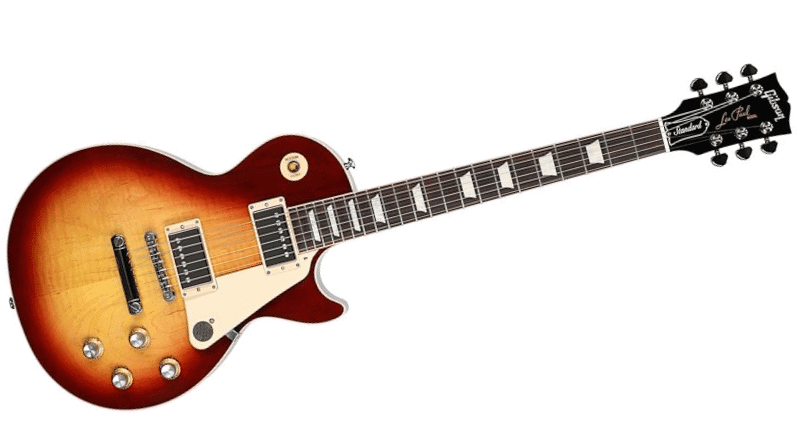
Make no mistake, this may be called the Standard, but that’s not because it’s basic. With a Standard you’re still getting beautifully flamed maple tops, high end pickups, a PLEK job on the fret work, and a choice of 2 necks – the ‘50s vintage profile (think thick like a baseball bat), or the ‘60s SlimTaper (a much thinner, more ergonomic neck). Both varieties of the LP standard come with BurstBucker pickups, which are designed to replicate the legendary tones of the original PAF pickups of the ‘50s and ‘60s.
Les Paul Custom
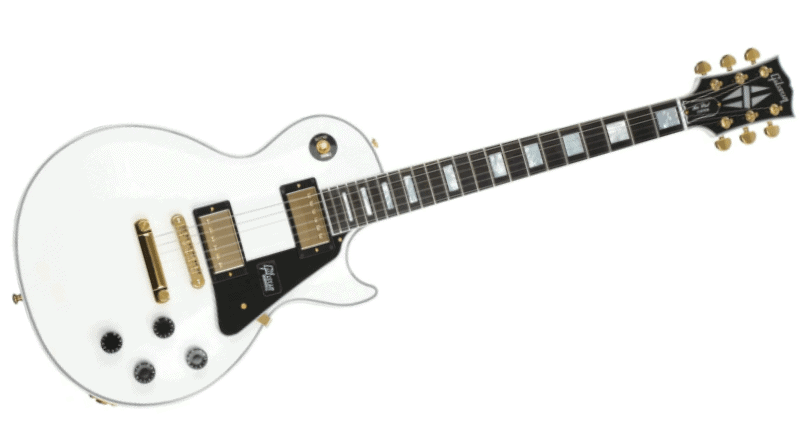
The Les Paul Custom is one of the showiest versions available. Often referred to as the tuxedo models because of their distinct ebony, and alpine white finishes, these models are breathed upon by the Custom Shop, and come complete with high end gold finished appointments, ebony fretboards, and more binding than you can shake a stick at.
Les Paul Tribute
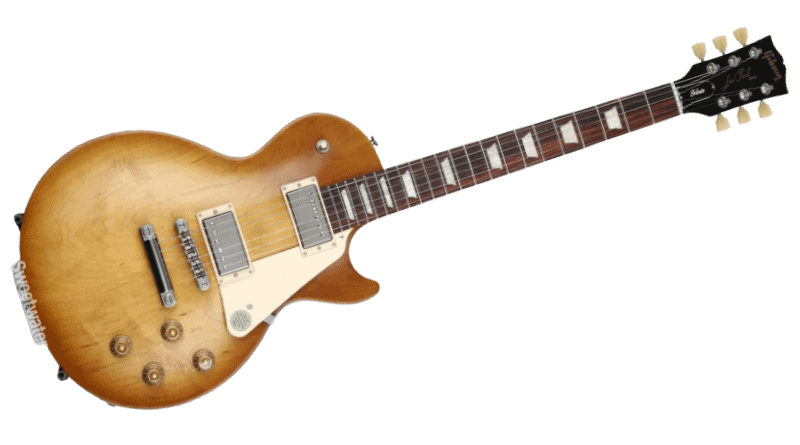
If you’re looking for an entry level model, the Les Paul Tribute is the most affordable new carved top Les Paul available. They are light on embellishments, and on weight thanks to their weight relieved bodies. There is no trim or binding on these models, and they come with a satin nitrocellulose finish.
Les Paul Junior
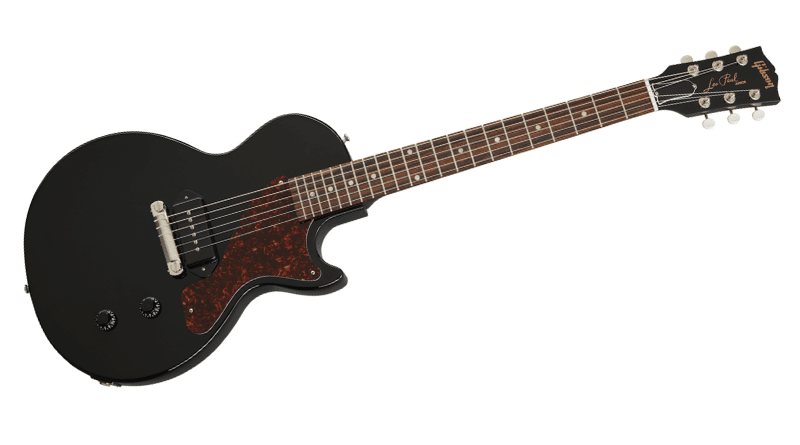
Originally designed as a student model, the Les Paul Junior features the same basic silhouette as a regular LP, but it has an all mahogany slab body with no carved maple top. In addition, the pickguard is affixed to the body (rather than floating like the Standard style). The Junior is fitted with a single P90 pickup, and is loved in punk circles for its rowdy tones.
- Massive sustain
- Stunning looks
- Comfortable scale length
- Nitro finish
- Heavy
- Expensive
- Limited upper fret access
- Headstock is prone to breaking
SG
The Gibson SG is one of the most iconic guitars in rock history. Used by everyone from Black Sabbath’s Toni Iommi, to Angus Young of AC/DC, the SG has been a mainstay of hard rock and heavy metal for over 50 years.
The origins of the Gibson SG can be traced back to 1961, when Gibson introduced it as the all new “Les Paul SG”, with SG standing for “Solid Guitar”. This new design was meant to be lighter and more comfortable to play than the outgoing Les Paul.
Throughout the remainder of the 1960s and into the 1970s, the Gibson SG remained one of the most popular guitars on the market. In particular, it was favored by hard rock and heavy metal guitarists for its huge sound and aggressive looks, most notably the devil-esque horns.
Today, the Gibson SG is still widely used by rock guitarists all over the world and continues to be one of Gibson’s best-selling models. In fact, the SG is the model with the longest unbroken production history Gibson has ever made – since its introduction in 1961, they have never stopped making this guitar!
Construction
Similar to the Les Paul, the Gibson SG is made from solid mahogany, but that’s pretty much where the similarities end. The SG’s body is much thinner than the Les Paul, and there is no maple cap. It features double cutaways for improved access to the upper frets.
The SG is another model that features a set neck. Some of the cheaper Epiphone versions come with bolt on necks, but the traditional construction technique does involve a glued neck. Because SGs were all from the ‘60s or later, the SlimTaper neck profile was the standard even on the earliest examples, which is why it’s prevalent on most SGs today.
Rosewood fretboards are the order of the day on most models, although like the Les Paul, the SG custom models do feature ebony boards. Modern examples receive a PLEK fret dressing prior to leaving the factory, too, which ensures everything is as level and well polished as it’s physically possible to be.
Gibson SGs are all made in the USA, and finished in Nitro lacquer, just like every other Gibson model that leaves the factory floor.
Like their Les Paul counterparts, most SGs get a pair of PAF style humbucking pickups, but some are fitted with P90s if that’s your preference.
A unique feature of the SG is that it is available with a vibrato arm, the Maestro Vibrola. The Vibrola is available as a standard setup, or with a sideways arm. These systems don’t produce quite the same pitch variation as a Floyd Rose, or even a Fender Synchronized Tremolo, but if you want a Gibson with a vibrato system, this is one of the few options available.
Tones
You may find yourself thinking that with largely the same pickups, and a mahogany body, does the SG not just sound like the Les Paul? The answer is a resounding no. Because the SG is much thinner and lighter, it has more mid range presence than the LP and its lower mids and bass heavy tone.
In addition, the SG doesn’t have a maple cap to add brightness and snap. This keeps it a bit darker, and explains a lot about why it’s been so popular in heavy metal and hard rock.
The SG is also available, in some cases, with coil splitting pickups. In all cases (except for the Junior with its single pickup), the SG features dual volume and tone controls.
Playability
Improved playability was one of Gibson’s prime objectives when they set about designing and building the SG. They thought by making the guitar thinner, and lighter, while still giving it gut punching humbuckers, it would fill the gaps left by the already excellent, but outgoing, Les Paul.
In many cases this was true. To this day, the SG is still one of the most comfortable guitars to play. Its ergonomics were well ahead of its time, particularly thanks to the beveled edges on the front and back of the body.
The one thing that wasn’t accounted for was neck dive. The SG was (and in many cases still is) notorious for neck dive. The position of the top strap button, combined with the lighter body weight created something of an imbalance, which causes the neck of the guitar to fall towards the headstock. This can be extremely fatiguing for those playing gigs from a standing position, and is one of the biggest drawbacks of an otherwise wonderful guitar.
Favorite Models
SG Standard
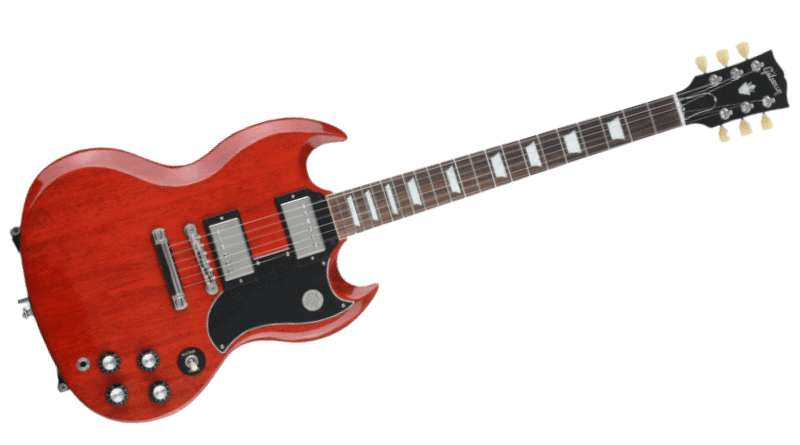
The SG standard is really the flag bearer for the model. It’s available as the SG Standard, which is the more modern design, or, the SG ’61 Standard, which is based on the original ’61 Les Paul SG. In both cases it’s available in just 2 finishes, Ebony, and Heritage Cherry (called Vintage Cherry on the ’61).
The SG Standard is fitted with the full “batwing” pickguard, while the ’61 gets the period correct half pickguard. It’s also worth noting that the modern Standard is fitted with 490R/490T humbuckers, while the ’61 gets BurstBuckers.
SG Modern
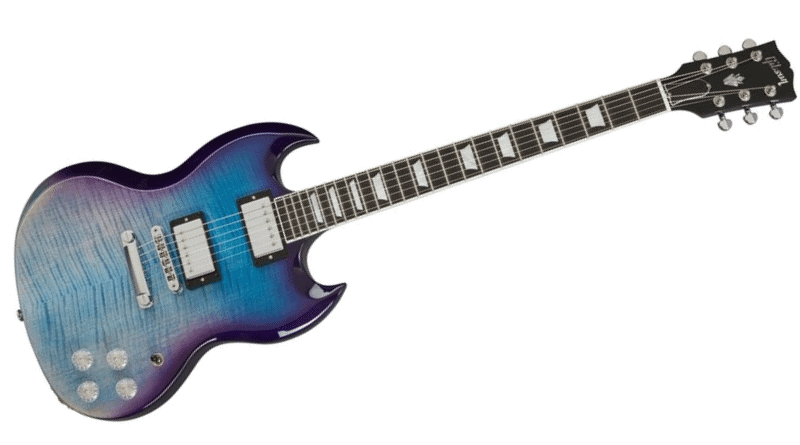
The Gibson SG Modern is a bit of an exception to the rule insomuch as it has a maple top. This isn’t a heavy maple top like a Les Paul, but rather a thin veneer applied in order to showcase some absolutely stunning flamed figuring. These Modern models feature a pair of matched BurstBucker Pro pickups for classic PAF tone, and also include both coil tapping and coil splitting for a huge variety in tonal capability.
SG Custom 1964 Standard Reissue Murphy Lab
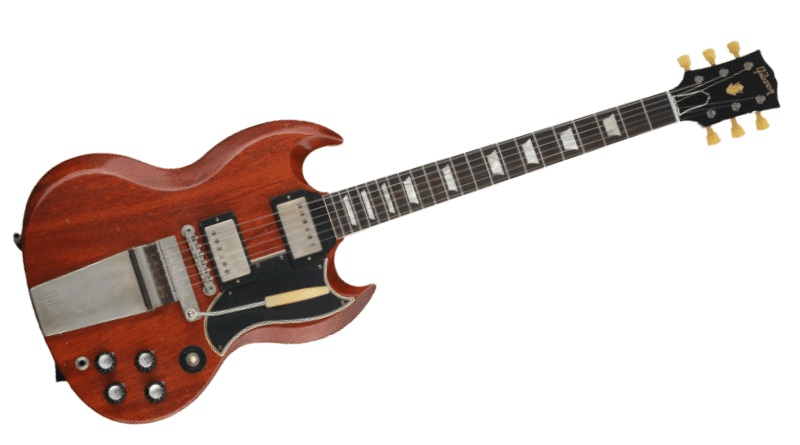
This is a spectacular version of the Gibson SG that has been crafted to perfectly replicate a genuine 1964 model. Because it came from the Murphy Lab, it’s also been expertly aged to give the appearance of being a real ’64 model. Whether or not you agree with artificial patina, there’s no arguing that this is a stunning guitar with some phenomenal tones.
- Light weight
- Comfortable to play
- Vibrola available
- Excellent upper fret access
- Prone to neck dive
- Less Sustain
- Fewer finish options than the Les Paul
Affordable Versions
While the Gibson models may be the originals, and arguably the best, we understand that not everybody is working with a Gibson Budget. Fortunately, Epiphone makes licensed versions of both the Les Paul and the SG, and we’re happy to report they’re absolutely wonderful. Epiphone makes the Junior, the Standard, and the Custom for both the Les Paul and the SG, and in blind tests even the experts have a hard time telling which is which.
Final Thoughts on the Gibson SG vs Gibson Les Paul
Asking us to pick a favorite between the Les Paul and the SG is just like asking us to pick which of our kids is the favorite. You might have one secretly in mind, but you’ll never admit it out loud. While both models are capable of performing admirably in pretty much any genre you could ever think of, the reality is that they sound so different, that it’s absolutely going to boil down to personal preference.
If you like a jack of all trades, rock and roll type tone, the Les Paul is going to serve you very well. Aesthetically it’s universally loved, and as far as tones go, it’s really a sensational model. If you’re looking for all out hard rocking, improved playability, and more mid range in your tones, look at picking up an SG. In an ideal world you’d have one of each anyway!

